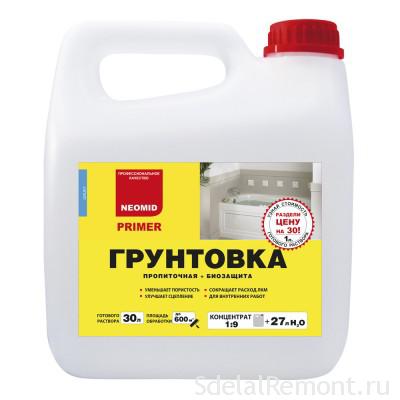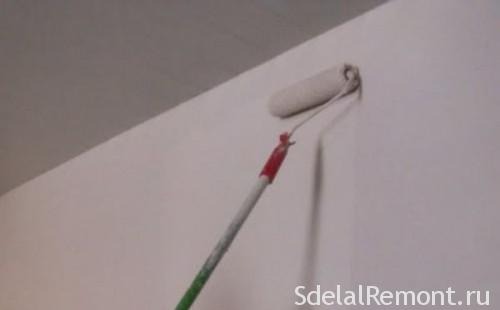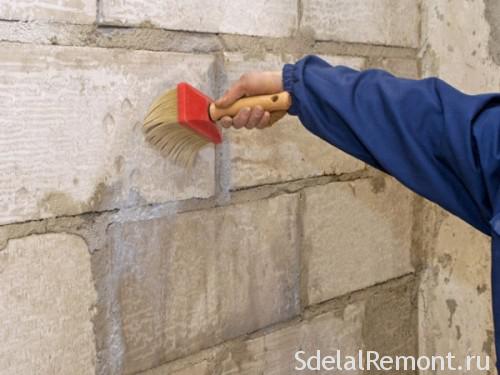The use of mixtures of primers for repair sufficiently substantiated, because any finishing material must be kept on the basis of a very strong and reliable. For this purpose, the primer, and what to choose for the walls and the flow will help you this article.
Types of modern primer
Modern manufacturers offer a huge amount of primer mixtures. Select the appropriate types of primers for concrete, plaster, putty is not always easy. For this purpose, it is necessary to, first of all, known species.

Depending on the application, types of primers for walls and ceiling are divided into the following groups:
- alkyd: It applies only for wooden surfaces and structures made of metal;
- acrylic: have universal properties, respectively, suitable for different surfaces. Compositions of this group to penetrate deep into 1 cm. this property allows you to use acrylic primer for deep impregnation base;
- aluminum: only used for wood. With their aid timber is completely isolated from moisture, thereby minimizing the occurrence of such unpleasant phenomena, like mold or fungus;
- PVA: apply only when using inks specially formulated for concrete primer, wood, metal, plaster;
- Shellac: It helps to prevent the allocation of tree resin, respectively, It used as species primer for the ceiling and walls;
- epoxy: useful as deep Surface treatment of metal and concrete. Their main advantage - corrosion protection and sufficient strong adhesion.
Based on the above classification, before, as choose a primer for walls, necessary to determine the material surface, subject to the primer, and only then acquire a mixture of.
choosing primer, Pay attention to the manufacturer, price and specifications. The deeper the level of penetration in the soil base, the better it is for all purposes.
All of the acrylic compositions
The most common primer which you can choose in different cases - this acrylic. It is versatile and makes the final finish quality and durable. In turn, the types of acrylic primers also have their own classification and depending on the application and purpose priming divided into:
1. Universal: used on all surfaces and in all conditions. This primer is equally well suited for both internal, and exterior painting and decorating. If you do not know, how to choose a wallpaper primer, what to use for subsequent tiling or simply painting, take universal. A solution of this mixture was slightly unclear, almost colorless. A special place in a wide range of universal acrylic primer takes very popular today primer paint. Its use helps to solve several problems at the same time: securely seal surface, get rid of the possible occurrence of mold and fungal bacteria, apply a coat of paint. The composition of the white color and the surface is not only primed, but colored.
Council: buy ground-paint can in any store. It is possible to achieve the desired color, adding a dye primer. for example, After priming the wall is planned to paint in blue. Add the blue dye and a first layer of paint ready.
2. Compositions deep penetration are all characteristic quality acrylic primers. but, primer of this type is much more deeply penetrate the surface to be treated, flatten it, thus stronger interlocking base.
absorption length is 1 cm. In question, how to choose the primer deep penetration or other universal, primacy should be given to the first group. smoothing effect makes the surface perfectly flat, since there is bonding of fine particles, sand and dust. This is a great option, both primed the wall under the wallpaper, plaster and even the tiles.
3. adhesive: as part of an admixture of quartz have, which makes the surface a little rough, what, in turn, much stronger glues heavy decoration materials. This is a good way out, when you do not know, what primed the wall before plastering.

methods of application: when and how to do it
primer application method does not fundamentally different from other methods of applying finishing materials. the surface is cleaned, trimmed, polished and degreased, if necessary. On the question of, how many times you need to prime the walls or ceiling, It requires an individual approach, but at least two times.
For the application of such tools are used, as:
- bead.
- Brush.
- Pulvezator.

In each case, the tool is individually. for example, apply primer to the brick surface with a brush better, but on a flat ceiling or drywall - roller. Pulvizator used less often, since it is not easy to wash after the room.
Preparing the ceiling
Since repair of the ceiling in the home, You need to examine information on, how to properly prime the ceiling. After all, despite the seeming simplicity of operation, there are certain rules:
- defining, what primed ceiling, try to make it evenly. malapportionment, after painting will be immediately evident. A place, wherein the primer is applied thicker, will darken, than the entire surface.
- Before, as the ceiling primed before painting, select the direction of applying the bonding material. When one layer of primer is done along the premises, perpendicular to the wall with a window. When applying the first layer of the bilayer is parallel to the wall with window, second - perpendicular to the same.
Preparing walls
Primed the wall is necessary in any case,. Another question, better primed wall, But more on that later. Before priming the surface requires mandatory training: it is necessary to remove the old paint, smooth out irregularities, putty gap, remove dust and dirt.
The paper should follow technology, and not do anything in haste. The first coat of primer should be sure to dry and then you can apply a second layer. It is necessary to evenly distribute the. Particular attention should be to focus on the moment, when you need to prime the walls under heavy wallpaper. In such cases, it can not be used as a primer wallpaper glue (how many are advised).
Of course, You could argue, why you need to prime the walls, if they will still be plastered? First of all, wallpaper will be held firmly, will not bubble when glueing. Yes, and in the future on such walls will not appear any dirty trick in the form of mold or mildew.
How and what primed the walls for painting
Priming the walls necessarily, and the question of whether, what primed the walls before painting, we can safely say - a universal primer. It has all the necessary properties and is suitable for different situations.
It is often necessary to solve, Do I need to be primed before painting? Some believe there is no: primer mixture, drying up, It leaves the band, which clearly distinguished after dyeing. A dust and dirt can be removed with a vacuum cleaner. other, conversely, claim, that to do so it is necessary to. Here it is necessary to decide on their own. Prices of practical repair - primed, You want to save money - not soil.
Often the walls are made of drywall, as it is affordable and practical material. Usually, it is perfectly smooth and, respectively, many interested, whether it is necessary to prime the drywall? Yes, necessarily, because the priming process is not only aligns the wall, but also serves as a great factor in the base trim clutch.
Used in this case,, Again, a universal primer, doing the work in the following sequence:
- Primed for the first time;
- Shpaklyuyut;
- Hruntuyut again.
Only after complete drying, proceed to surface staining.
Council: when working with primer room temperature should be within 5-20 degrees of heat, air humidity 75 % and no drafts.
How and what primed the wall under plaster

Plaster is used on brick, concrete or aerated concrete surfaces. They, usually, have high friability and absorbency, and the question, Do I need to be primed before plastering, beyond doubt. Chosen in these cases, Primers, deep penetration. Not only does it perfectly links the, but also has antiseptic properties.
Primed before plastering is necessary in several layers. Better use a brush or roller. Drying each layer about an hour and in this time it is necessary to protect the walls from contact with dust and dirt. Temperature readings of this type are the same with the universal primer. The main thing - carefully read the instructions and follow it.
Exactly the same requirements apply, when the question arises, Do I need to be primed before the filler. All the same, even more, because in pure filler layer will not hold any finishing material.
In this way, Summarizing all the above, it should be noted the most important: The primer surface should be necessarily, this should be done in accordance with the rules, selecting a primer to prime the ceiling or wall.
About tom, how to properly prime the video wall will tell more.












